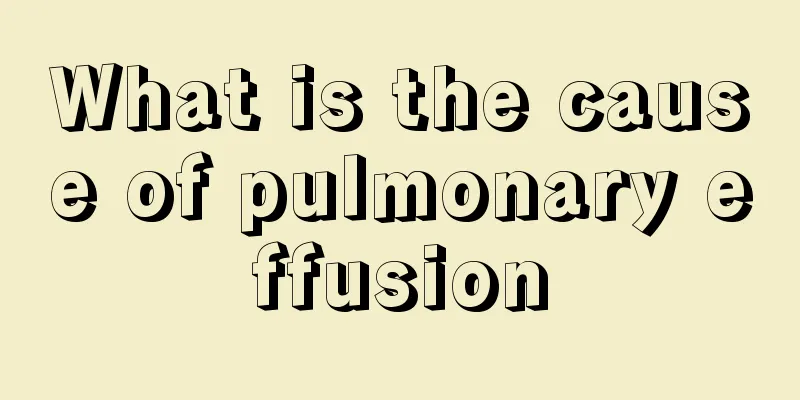What is the cause of pulmonary effusion

|
Pulmonary effusion is a condition in which there is a large amount of fluid in the lungs. There are two causes of pulmonary effusion: one is that the bronchial tubes are blocked, and the other is that the lungs are subjected to a certain amount of external pressure. The clinical manifestations of pulmonary effusion depend on the severity of the patient's condition, mainly including some breathing difficulties, lateral chest deformation, etc. Some patients with pulmonary effusion have no obvious symptoms. However, once lung effusion is discovered, timely treatment is required, otherwise it will have a great impact on the patient's respiratory function and cause great pain to the patient. Next, I will give you a detailed introduction to the causes, clinical manifestations and treatments of pulmonary effusion! 1. Causes of pulmonary effusion Pulmonary effusion indicates that there are obvious lesions in the lungs. If the pulmonary effusion is not treated, it will affect the patient's respiratory function. There are two causes of right-sided atelectasis, which can be caused by bronchial obstruction (including internal or external factors) or external pressure on the lungs. The most common causes of intrinsic bronchial obstruction are aspirated foreign bodies, thick mucus, inflammatory exudates, bronchial tumors, bronchial granulation tissue, or inflammatory bronchial stenosis. Extrinsic bronchial obstruction can be caused by lymphadenopathy (including tuberculosis, tumors, and sarcoidosis), peribronchial tumors, aortic aneurysms, heart enlargement (such as left atrial enlargement), and pericardial effusion. Lung collapse is caused by external pressure on the lungs, which may be caused by a large amount of pleural effusion or pneumothorax, intrathoracic tumors, chest depression (congenital, traumatic or postoperative) and diaphragm rise. 2. Clinical manifestations of pulmonary effusion The clinical manifestations of pulmonary effusion vary greatly and are closely related to the extent of atelectasis and the cause of it. Unilateral atelectasis is often accompanied by obvious dyspnea, and physical examination often reveals changes such as deformation of the affected side of the chest, disappearance of breath sounds, solid percussion sounds, and displacement of the trachea to the affected side. However, the symptoms of localized atelectasis may not be obvious, and the clinical signs are also atypical. Therefore, even if no lesions are found, examination and treatment should continue. Treatment of pulmonary effusion If the B-ultrasound shows that the amount of pleural effusion is large and easy to extract, please extract the effusion to temporarily relieve the symptoms. If the effusion is very small and there is no need to extract it, please continue with anti-infection treatment and actively control lung inflammation. If you do not want to undergo bronchoscopy, you can review the chest X-ray and lung CT scan while undergoing treatment, and compare the images to find out the cause and take appropriate treatment. |
<<: Does formaldehyde have a smell?
>>: Is it reliable to remove formaldehyde by air conditioning heating
Recommend
What is the reason for high dimer level
In order to ensure normal blood circulation in th...
What kind of plaster is good for knee arthritis
Knee arthritis is the most common type of arthrit...
Tinnitus, dizziness and unsteady walking are caused by these reasons
Tinnitus and dizziness are both common diseases i...
Is it good to drink black tea when you have a cold
There are many kinds of Chinese tea, among which ...
Is radiation treatment for nasopharyngeal cancer painful?
Is radiation treatment for nasopharyngeal cancer ...
How much water is best to drink a day
Water is the source of life. Without water, there...
What kind of plants are suitable for the bathroom
The bathroom is generally a relatively humid plac...
How to remove the fishy and pungent smell from pig's trotters
Pig's trotters are a kind of food that many p...
The more you take of this substance, the lower your risk of cancer
Want to predict how long you can live? Many peopl...
What is the reason for always having acne on the face
I always feel that it is a truth that beauty is c...
How to make more foam when washing your hair
In life, everyone needs to wash their hair. Some ...
Why is there back pain after being discharged from chemotherapy for ovarian cancer
Why do patients with lower back pain after chemot...
Sequelae of glioma surgery
Common sequelae, or complications, after surgery ...
Targeted drugs for lung cancer
The monthly fee for ordinary lung cancer targeted...
Can I exercise if I have uterine cancer?
Cervical cancer is the most common gynecological ...









